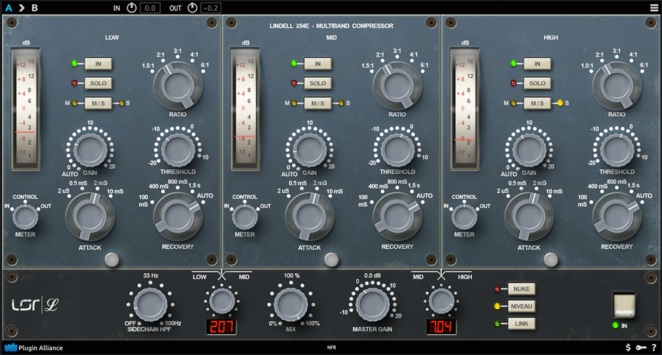New Plugin Review: Lindell Audio 354E Multiband Compressor/Limiter by Plugin Alliance
 Lindell Audio has become known for their vintage-inspired software designs.
Lindell Audio has become known for their vintage-inspired software designs.
Their PEX-500 EQ, based on the revered Pultec EQP-1A, garnered much attention from 500 series fans, and with the release of their 254E, the sound of the famed Neve 2254E compressor has become more attainable than ever before.
Lindell and Plugin Alliance have now released the 354E, a multiband hot-rod with some serious lineage.
At first glance, the 354E appears to be three 254Es split by two adjustable crossovers, but a closer look shows a number of powerful upgrades that make the 354E a very special kind of multiband compressor. Let’s find out why.
Features
Each of the three bands on the 354E are identical, and those familiar with the 254 already will feel right at home using them.
On the GUI, you’ll find the familiar Ratio, Threshold, Release, and Gain knobs alongside the unique vertical meters. While the 354 does not include the limiter circuit found on the single-band 254, it does provide a stepped attack-time control. While not completely variable, this is much more flexible than the simple slow/fast option of its predecessor.
At the top of each band are switches for “In” (band on/off), “Solo”, and a very useful and effective Mid-Side selector. Being able to adjust the Mid or Side for each band makes the 354 extremely flexible compared to your standard vintage-inspired fare.
Below the three compressor bands are the global controls. First is the sidechain filter—handy for controlling the amount of low frequency information hitting your detection circuit. Next, you’ll find the low crossover control, adjustable from 50Hz to 5kHz, and the mid/high crossover located a few knobs to the right, adjustable from 200Hz to 12kHz—both of which use phase-coherent 6dB/octave filters. In between the crossover controls is the now ubiquitous Mix (wet/dry) control and a Master Gain control.
To the right of these controls are a set of three vertical buttons that have a great effect on the compressor’s overall sound: The “Nuke” button does as advertised: It overloads the input, turning the 354 into a pumping, snarling beast. Below it, the “Niveau” button does pretty much the opposite, adding filters to the sidechain “to compensate for the natural 3dB/octave slope of music.” According the Lindell, this helps to get smoother compression. The bottom “Link” button is a switch to link the three compressions bands’ settings, and finally, to the far right is a master “In” switch, for total bypass of the354E.
In Use
In use, the Lindell 354E is seriously impressive. If you are searching for a surgical and transparent compressor, then read no further and continue your search elsewhere. From the moment I inserted the plugin, the first thought I had was “size.” This thing just makes sounds feel bigger, and in a very pleasing way.
I started out by trying it on drums, as I do with most things, and it added a wonderful gel to my drum bus. The high band is excellent for controlling crashes, and the 2ms attack time is plenty fast enough for skittering hi hats.
The 354E shines on vocals as well. It’s not so much a tool for zeroing in and controlling specific resonances—it’s more about taming different, more general parts of the vocal. The middle band handles the “body” of the vocal, while the high band is great for controlling sibilance, and the low for bass. However, depending on where the crossovers are set, the middle band can be narrowed to control boxiness, nasal issues, or other problem frequency ranges.
But the 354E’s true power lies in controlling program material. Similar to its use on vocals, this is more about shaping the sound than dissecting it. The Niveau filters do indeed make the compression extremely smooth, and I’ll say it again: The sound is huge! The M/S controls make it easy to focus in and grab a snare, vocal, or kick drum, as well as hard-panned keyboards and guitars. Combined with the musical attack and release settings, this is a truly powerful song-shaping tool.
To Be Critical
Finding anything to critique on the 354E is a stretch. Its sound is massive, and pleasing results can be achieved with great quickness and ease. The one thing I will say is the GUI is on the larger side, so it may take up too much screen space for some—but for me, that’s really not a deal breaker. I suppose one could ask for individual wet/dry controls per band for added flexibility, but let’s not get greedy.
Summing it Up
Tools of this quality beg the question that many recordists are faced with in an increasingly software-driven landscape: Why have one great piece of hardware when you can have limitless instances of its software counterpart? With the obvious monetary restrictions of acquiring piles of vintage gear that can only be used once per song, the 354E’s price point of $199 seems well-justified.
There are plenty of vintage compressor models in the world, and while the Neve 2254 is not the most common, the Lindell 254E is a great emulation—and the 354E is a dream upgrade from that. It is flexible, musical, and most importantly, sounds fantastic on everything, be it individual tracks, buses or even full mixes or masters.
Please note: When you buy products through links on this page, we may earn an affiliate commission.






